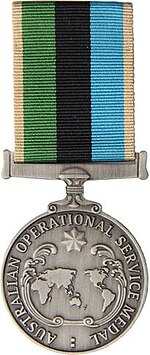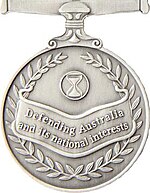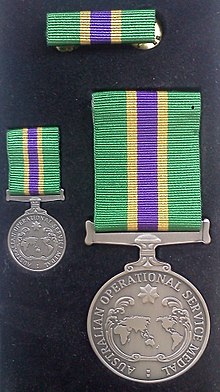Australian Operational Service Medal
| Australian Operational Service Medal | |
|---|---|
  Australian Operational Service Medal with: "Border Protection" ribbon (top) and "Greater Middle East Operation" ribbon | |
| Type | Campaign medal |
| Awarded for | Service on declared hazardous operations |
| Presented by | Australia |
| Eligibility | Military – Willingly and ably perform their work as part of an operation or within other specific hazardous environments and conditions. Civilian – Defence civilians, and other classes of civilian who are employed on ADF operations under the provisions of the Defence Force Discipline Act 1982.[1] |
| Clasps | "accumulated service device" for military awards[2][3] Clasps for operations for civilian awards[2][4] |
| Status | Currently issued |
| Established | 22 May 2012 |
| First awarded | 12 December 2012[5] |
 Reverse | |
| Order of Wear | |
| Next (higher) | Australian Service Medal |
| Next (lower) | Rhodesia Medal |

The Australian Operational Service Medal is a campaign medal established on 22 May 2012 to recognise service by Australian Defence Force (ADF) personnel on designated hazardous operations. It may also be awarded to civilians who serve alongside the ADF on designated operations under specific conditions.
It replaces the Australian Active Service Medal and Australian Service Medal for future ADF operations. The medal is issued to military personnel with a different ribbon for each designated operation. When issued to civilians, a standard ribbon is issued with clasps issued for each designated operation.
Overview
[edit]The Australian Operational Service Medal is a campaign medal established by Royal Letters Patent on 22 May 2012.[6] This campaign medal was instituted as a replacement for future issues of the Australian Active Service Medal and Australian Service Medal and operational campaign medals for the Australian Defence Force, as well as to recognise the service of Defence civilians in declared operational areas.[7] It is awarded as either a military or civilian variant.[8]
Military version
[edit]The military version of the medal has a standard medal design, but ribbons vary by operation.[3] An accumulated service device will be awarded for subsequent qualifying service by ADF members where they undertake further service on an operation for which they have already been awarded the Australian Operational Service Medal.[3]
Ribbons
[edit]To date, four ribbons for ADF service have been announced:
| The Border Protection ribbon has three equal stripes of dark blue, ochre and dark green which denote the seas and sky, the deserts, and the forests and grasslands.[9] | |
| The Greater Middle East Operation ribbon has three equal stripes of mid green, black and light blue, edged by two slim stripes of light sand. Sand represents the desert sands, green represents Australia and hope, black represents anti-piracy, and blue represents the maritime and air aspects.[10][11] | |
| The Special Operations ribbon is 32 mm wide in black with a central stripe of red. Additional accumulated service is denoted by an 8 mm high Arabic numeral with an antique silver finish.[12] | |
| The Counter Terrorism/Special Recovery ribbon is 32 mm with black edges, symbolising counter-terrorism operations fading to grey to symbolise the urban nature of operations. The blue stripes, which flank the central white stripe, represent the broader contribution of the Special Operation command staff. The white symbolises the peaceful outcome as a final action.[13] | |
| The Africa ribbon is 32 mm as a central red stripe, flanked by black stripes of equal width, bordered with golden yellow and White stripes of equal width and edged with mid-green stripes.[14] |
Civilian version
[edit]The Australian Operational Service Medal (Civilian) was established to allow for recognition of Defence civilians, who had agreed to be subject to the Defence Force Discipline Act 1982 and were employed overseas to support the operations of a deployed military force in a declared area of operations. The civilian version uses the same medal design as the military version, but is awarded with a unique civilian ribbon and a clasp denoting the declared operation.[15] Subsequent qualifying service for civilians will be (is) denoted by clasps.[15]
| The Civilian ribbon is green with central stripes of gold and purple. The purple represents Defence, and the green and gold are Australia's national colours. |
Clasps
[edit]Clasps announced (and awarded) to date are listed below.
Variants for declared operations – Military version
[edit]Australian Operational Service Medal – Border Protection (AOSM-BP)
[edit]The variant for border protection operations was announced on 19 July 2012. This variant will be (is) awarded to Australian Defence Force personnel who have served on border protection operations since 1997. The ribbon for the medal is 32 mm wide with a central stripe of ochre flanked by one blue stripe and one green stripe of equal width.[16]
The declared operations are:
| Operation | From | To | Notes |
|---|---|---|---|
| CRANBERRY | 1 August 1997 | 16 July 2006 | [16][17] |
| DIRK | 1 September 1997 | 31 October 1997 | [16] |
| STANHOPE | 3 February 1998 | 6 March 1998 | [16] |
| MISTRAL | 1 August 1998 | 30 June 2006 | [16] |
| TEEBONE | 1 March 2001 | 31 March 2001 | [16] |
| CELESTA | 1 August 2001 | 31 July 2006 | [16][18] |
| SUTTON | 25 January 2002 | 19 February 2002 | [16] |
| GEMSBOK | 29 August 2003 | 3 October 2003 | [16] |
| RELEX | 3 September 2001 | 13 March 2002 | [16] |
| RELEX II | 14 March 2002 | 16 July 2006 | [16][19] |
| RESOLUTE | 17 July 2006 | ongoing | [16][20] |
Personnel who served on naval vessels, maritime patrol aircraft or Regional Force Surveillance Unit patrols whilst assigned to any of these operations may be eligible.[21]
Members of the Australian Defence Force must have served either an aggregate of 30 days either deployed or force assigned as a member of one of the declared operations, or were deployed or force assigned to a declared operation and completed 30 sorties from a unit assigned to the operation, so long as the sorties were conducted over a period of not less than 30 aggregate days with no more than one sortie counted per day.[16]
Members must also have been:[16]
- Deployed at sea directly supporting a declared operation
- Deployed on land or in the air, dedicated in support of a declared operation
- Deployed forward to exclusively support a declared operation.
Exclusions
[edit]Members are not eligible for an award of the AOSM-BP where an entitlement exists to another Australian medal for the same deployment.
Members are not eligible for an award of the AOSM-BP where the member was part of:
- Headquarters staff at Joint Operations Command;
- Headquarters staff at Northern Command;
- Headquarters staff at Military Strategic Commitments;
- Headquarters staff at Regional Force Surveillance Unit;
- Australian Defence Force staff at Border Protection Command; or
- Base maintainers and support personnel
- Rifle Company Butterworth personnel providing direct support to Border Protection operations via airfield and aircraft security.
Australian Operational Service Medal – Greater Middle East Operation (AOSM-GMEO)
[edit]The eligibility requirements for this medal are:
- 30 days service, continuous or aggregated, on either of the below operations
- The ADF member is force assigned for operational duties.
The declared operations are:
| Operation | From | To | Notes |
|---|---|---|---|
| MANITOU | 1 July 2014 | ongoing | [22][23] |
| ACCORDION | 1 July 2014 | ongoing | [22][23] |
| HIGHROAD | 1 January 2015 | ongoing | [24] |
| OKRA | 1 January 2015 | 20 December 2024 | [24] |
| MAZURKA | 1 November 2023 | ongoing | [25] |
| PALADIN | 1 November 2023 | ongoing | [25] |
| FORTITUDE | 1 November 2023 | ongoing | [25] |
| STEADFAST | 10 September 2018 | ongoing | [25] |
Australian Operational Service Medal – Africa (AOSM-A)
[edit]The eligibility requirements for this medal are:
- 30 days service, continuous or aggregated, on either of the below operations
- The ADF member is force assigned for operational duties.
The declared operations are:
| Operation | From | To | Notes |
|---|---|---|---|
| ASLAN | 1 November 2023 | ongoing | [14] |
| ORENDA | 1 April 2020 | 31 December 2023 | [26] |
Clasps for declared operations – Civilian version
[edit]
On 12 December 2012, the Governor-General declared, for the purposes of the Australian Operational Service Medal Regulation 2012, a number of declared operations, and determined the conditions for award of Clasps.[4]
- General conditions for all Clasps include
- awarded to a civilian who was employed for duty on the declared operation for a period of not less than an aggregate of 30 days;[4]
- Specific conditions for each Clasp include
| Theatre | Operation | Declared period | Clasp name | Notes | |
|---|---|---|---|---|---|
| from | to | ||||
| East Timor | TANAGER | 20 February 2000 | 19 May 2002 | EAST TIMOR | [4] |
| East Timor | CITADEL | 20 May 2002 | 19 May 2004 | EAST TIMOR | [4] |
| East Timor | SPIRE | 20 May 2004 | 21 May 2005 | EAST TIMOR | [4] |
| various | SLIPPER | 11 October 2001 | 1 August 2002 | ICAT | [4][27] |
| various | SLIPPER | 11 October 2001 | 30 July 2009 | ICAT | [4][28] |
| various | SLIPPER | 31 July 2009 | 19 February 2012 | ICAT | [4][29] |
| various | SLIPPER | 20 February 2012 | 30 June 2014 | ICAT | [4][30][31][32] |
| Afghanistan | SLIPPER | 1 July 2014 | ICAT | [31][33] | |
| various | FALCONER | 18 March 2003 | 22 July 2003 | IRAQ 2003 | [4][34] |
| various | CATALYST | 16 July 2003 | 31 July 2009 | IRAQ 2003 | [4][35] |
| Solomon Islands | ANODE | 24 July 2003 | 1 August 2013 | SOLOMON IS II | [4] |
| Timor-Leste | ASTUTE | 12 May 2006 | 25 May 2013 | TIMOR-LESTE | [4] |
| various | MANITOU | 1 July 2014 | ongoing | G.M.E. OPS | [36][23] |
| various | ACCORDION | 1 July 2014 | ongoing | G.M.E. OPS | [36][23][37] |
See also
[edit]- Australian Honours Order of Precedence
- Australian campaign medals
- Australia Service Medal 1939–45
- Australian Active Service Medal 1945–1975
- Australian Active Service Medal
- Australian Service Medal 1945–1975
- Australian Service Medal
- Police Overseas Service Medal (Australia)
- Humanitarian Overseas Service Medal
- National Emergency Medal (Australia)
- Civilian Service Medal 1939–1945
- List of military operations involving Australia
References
[edit]- ^ "Australian Operational Service Medal – Civilian". Defence Honours & Awards. Department of Defence. Archived from the original on 8 August 2013. Retrieved 19 August 2013.
- ^ a b Ray Griggs (20 July 2012). "Operational Service Medal – Border Protection". Royal Australian Navy (Press release). Archived from the original on 8 October 2012. Retrieved 4 December 2012.
- ^ a b c Gazette No. S 67 (PDF), 6 June 2012, p. 3
- ^ a b c d e f g h i j k l m n Her Excellency the Governor-General of the Commonwealth of Australia (12 December 2012). "Declaration and Determination under the Australian Operational Service Medal Regulation 2012" (PDF). Archived from the original (PDF) on 12 February 2014. Retrieved 20 April 2013.
- ^ "ADF members on Border Protection operations honoured". Navy News. navy.gov.au. 12 December 2012.
- ^ "Letters Patent and Australian Operational Service Medal Regulations 2012" (PDF). Australian Government Gazette No. S 67. Canberra, Australia: Commonwealth of Australia. 6 June 2012. p. 1. Retrieved 19 July 2012.
- ^ "Australian Operational Service Medal (OSM)". Defence Honours and Awards, Defence Support Group. Canberra, Australia: Department of Defence. Archived from the original on 23 June 2012. Retrieved 27 June 2012.
- ^ Gazette No. S 67 (PDF), 6 June 2012, pp. 3–4
- ^ Australian Operational Service Medal – Border Protection, www.defence.gov.au
- ^ Australian Operational Service Medal – Greater Middle East Operation – Instrument 2015, www.defence.gov.au
- ^ Australian Operational Service Medal – Greater Middle East Operation, www.defence.gov.au
- ^ Reynolds, Linda. "Determination under the Australian Operational Service Medal Regulation 2012 (Special Operations) 2019" (PDF). Governor General of Australia. Retrieved 2 November 2019.
- ^ Reynolds, Linda. "Australian Operational Service Medal Regulation 2012 (Counter-Terrorism / Special Recovery) Determination 2020" (PDF). Governor General of Australia. Retrieved 10 November 2020.
- ^ a b "Australian Operational Service Medal (Africa) Instrument 2023" (PDF). Australian Gazette. Governor General of Australia. Retrieved 22 November 2023.
- ^ a b Gazette No. S 67, 6 June 2012, p. 4[dead link]
- ^ a b c d e f g h i j k l m n Quentin Bryce (18 July 2012). "Declaration Under the Australian Operational Service Medal regulation 2012" (PDF). Australian Department of Defence. Commonwealth of Australia. Archived from the original (PDF) on 3 October 2012. Retrieved 18 November 2012.
- ^ Op Cranberry, www.defence.gov.au Archived 2012-10-05 at the Wayback Machine
- ^ Op Celesta, www.defence.gov.au Archived 2012-10-05 at the Wayback Machine
- ^ Op Relex II, www.defence.gov.au Archived 2012-10-05 at the Wayback Machine
- ^ Op Resolute, www.defence.gov.au Archived 2010-07-06 at the Wayback Machine
- ^ Snowdon, Warren (19 July 2012). "New Medal of Recognition for Defence". Minister for Defence Science and Personnel Media Release. Canberra, Australia: Department of Defence. Archived from the original on 8 November 2012. Retrieved 19 July 2012.
- ^ a b His Excellency the Governor-General of the Commonwealth of Australia (4 September 2014). "Australian Operational Service Medal (Greater Middle East Operation) – Instrument 2014" (PDF). www.defence.gov.au.
- ^ a b c d The Greater Middle East Operation that commenced on 1 July 2014 is a declared operation comprising:
(a) Operation MANITOU, involving ... all waters, ports ... and airspace of: (i) the Persian Gulf; (ii) the Gulf of Aden; (iii) the Red Sea; (iv) the Arabian Sea; north of 11°S and west of 68°E
(b) Operation ACCORDION, involving ... Bahrain, Qatar and the UAE. - ^ a b "Australian Operational Service Medal - Greater Middle East Operation". Department of Defence. 26 September 2013. Archived from the original on 22 July 2019. Retrieved 14 July 2019.
- ^ a b c d "Australian Operational Service Medal (Greater Middle East Operation) Instrument Amendment 2023 (No. I)" (PDF). Australian Gazette. Governor General of Australia. Retrieved 22 November 2023.
- ^ "Operation Orenda | Defense Australia". Australian Department of Defense.
- ^ ICAT A) Operation SLIPPER – for the period 11 October 2001 to 1 August 2002:
- within the Diego Garcia land mass and territorial waters,
- plus airspace of Diego Garcia
- out to 250 nautical miles radius (from Reference Point 07° 18.6' South Latitude, 72°24.6' East Longitude)
- or declared Air Defence Identification Zone,
- whichever is greater
- ^ ICAT B1) Operation SLIPPER – for the period 11 October 2001 to 30 July 2009:
within the area bounded by:48°00' North Latitude,
35°00' East Longitude48°00' North Latitude,
81°00' East Longitude12°00' North Latitude,
35°00' East Longitude12°00' North Latitude,
81°00' East Longitude - ^ ICAT B2) Operation SLIPPER – for the period 31 July 2009 to 19 February 2012:
within the area bounded by:39°N, 32°E 39°N, 78°E 05°S, 32°E 05°S, 78°E - ^ ICAT B3) Operation SLIPPER – for the period commenced 20 February 2012:
within the area bounded by:39°N, 32°E 39°N, 78°E 23°N, 68°E 23°N, 78°E 17°N, 32°E 17°N, 38°E 11°S, 38°E 11°S, 68°E - ^ a b His Excellency the Governor-General of the Commonwealth of Australia (4 September 2014). "Australian Operational Service Medal (Civilian) with clasp International Coalition Against Terrorism – Instrument 2014" (PDF). www.defence.gov.au.
- ^ ICAT2014-A4) Identical to ICAT B3 above, but with the addition of the phrase: "and ended on 30 June 2014"
- ^ ICAT2014-A5) commenced on 1 July 2014 within the land territory, internal waters and superjacent airspace of Afghanistan
- ^ IRAQ 2003 i) Operation FALCONER — for the period 18 March 2003 to 22 July 2003:
in the specified areas comprising the following:38°N, 32°E 38°N, 68°E 10°N, 32°E 10°N, 68°E - ^ IRAQ 2003 ii) Operation CATALYST — for the period 16 July 2003 to 31 July 2009:
in the area comprising the total land areas, territorial waters, internal waterways and superjacent airspace boundaries of Iraq, Kuwait, Bahrain, Qatar, United Arab Emirates, Saudi Arabia north of 23 degrees North latitude, the Persian Gulf and the Strait of Hormuz - ^ a b His Excellency the Governor-General of the Commonwealth of Australia (4 September 2014). "Australian Operational Service Medal (Civilian) with clasp Greater Middle East Operation – Instrument 2014" (PDF). www.defence.gov.au.
- ^ "AOSM - C March 2022" (PDF). Australian Gazette. Governor General of Australia. Retrieved 22 November 2023.
External links
[edit]- Image of medals laid out prior to presentation, Royal Australian Navy Media Library.
- Australian Operational Service Medal, www.defence.gov.au
- Australian Operational Service Medal – Border Protection, www.defence.gov.au
- Australian Operational Service Medal – Civilian, www.defence.gov.au
